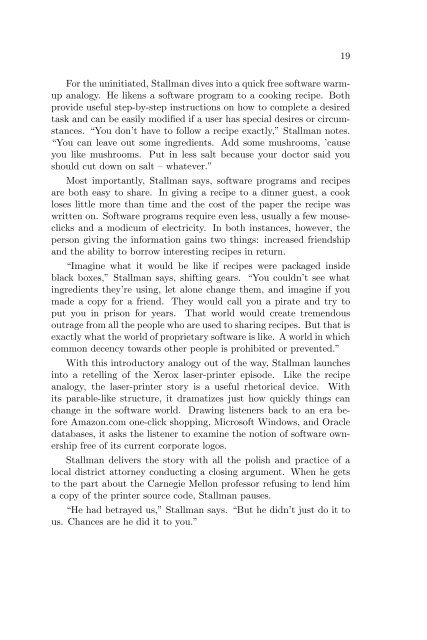Create successful ePaper yourself
Turn your PDF publications into a flip-book with our unique Google optimized e-Paper software.
For the uninitiated, Stallman dives into a quick free software warmup<br />
analogy. He likens a software program to a cooking recipe. Both<br />
provide useful step-by-step instructions on how to complete a desired<br />
task and can be easily modified if a user has special desires or circumstances.<br />
“You don’t have to follow a recipe exactly,” Stallman notes.<br />
“You can leave out some ingredients. Add some mushrooms, ’cause<br />
you like mushrooms. Put in less salt because your doctor said you<br />
should cut down on salt – whatever.”<br />
Most importantly, Stallman says, software programs and recipes<br />
are both easy to share. In giving a recipe to a dinner guest, a cook<br />
loses little more than time and the cost of the paper the recipe was<br />
written on. Software programs require even less, usually a few mouseclicks<br />
and a modicum of electricity. In both instances, however, the<br />
person giving the information gains two things: increased friendship<br />
and the ability to borrow interesting recipes in return.<br />
“Imagine what it would be like if recipes were packaged inside<br />
black boxes,” Stallman says, shifting gears. “You couldn’t see what<br />
ingredients they’re using, let alone change them, and imagine if you<br />
made a copy for a friend. They would call you a pirate and try to<br />
put you in prison for years. That world would create tremendous<br />
outrage from all the people who are used to sharing recipes. But that is<br />
exactly what the world of proprietary software is like. A world in which<br />
common decency towards other people is prohibited or prevented.”<br />
With this introductory analogy out of the way, Stallman launches<br />
into a retelling of the Xerox laser-printer episode. Like the recipe<br />
analogy, the laser-printer story is a useful rhetorical device. With<br />
its parable-like structure, it dramatizes just how quickly things can<br />
change in the software world. Drawing listeners back to an era before<br />
Amazon.com one-click shopping, Microsoft Windows, and Oracle<br />
databases, it asks the listener to examine the notion of software ownership<br />
free of its current corporate logos.<br />
Stallman delivers the story with all the polish and practice of a<br />
local district attorney conducting a closing argument. When he gets<br />
to the part about the Carnegie Mellon professor refusing to lend him<br />
a copy of the printer source code, Stallman pauses.<br />
“He had betrayed us,” Stallman says. “But he didn’t just do it to<br />
us. Chances are he did it to you.”<br />
19


